As we get ever closer to the FIFA Women’s World Cup, the excitement and tension get higher and higher. This competition pits nations against each other and the stakes could not be higher. Starting off the wonderful competition, as the second game, will be the matchup between China and Germany. Both teams are high octane teams and will be looking to notch the first victory for their passionate fans. In this tactical analysis, we will look at each team’s tactics and statistics to show you what they might play.
Squad
Heading into the matchup, Martina Voss-Tecklenburg and Die Nationalelf look to have no current injuries in their squad. The same goes for Jia Xiuquan and The Steel Roses. As such both the teams for Germany and China look to have no major injuries or muscle strains on any of their players.
Germany’s strict 4-4-2 looks to defend opposition play on the wings
Germany play in a standard yet specialised 4-4-2. While normally, the function of a 4-4-2 is to increase the width that the team plays in, Germany play in a different fashion. They utilize the 4-4-2 to control the centre corridor. They do this by having the wingers tuck in and have the defensive and attacking lines close to each other.
By controlling the centre, Germany reduce any potential holes in the middle of the pitch or between their lines. This practically means that the centre is closed off to the opposition and as such, they have no choice but to resort to wing play combinations. By doing this, Germany can isolate their defence to single sides of the pitch which allows them to regain the ball without any danger to their defence.
This retention of the ball is also aided by the rigidity of their structure as any balls that are played inside the 4-4-2 can be easily intercepted. This is due to the presence of a midfield pivot who can create 2v1s, a situation where there is numerical superiority in favour of Germany.
Moreover, due to the compactness of their positions, the defence is close to the midfield. This means that, if need be, one of the defenders can step up and transform a 2v1/2v2 to a 3v1/3v2. In both cases, the numerical superiority allows the ball to be retained while simultaneously creating triangles which can be used to start instant build-up.
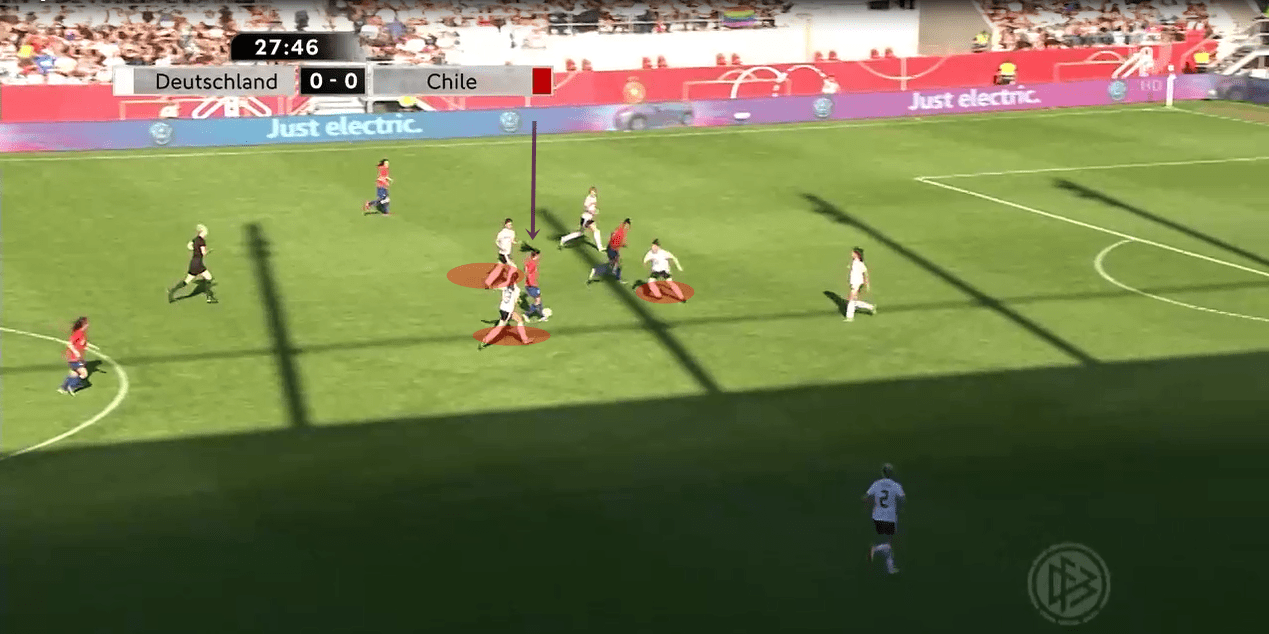
Here we see the midfield pivot surrounding the Chilean player. This is followed by the fact that one of the centre-backs steps up. Now, as seen with the red circles, Germany has three of its players against one Chilean player. This is a 3v1 situation in favour of Germany and this results in possession of the ball for Germany.
Germany’s high energetic results in expansive positions to launch attacks
One of the main characteristics of the German team under Voss-Tecklenburg, the manager, is Die Nationalelf’s tendency to play high energy football. This corresponds to an aggressive pressing by the team, especially when there is a loss of possession by one of their team members.
This high energy is also translated into an eager and expansive attack. As soon as Die Nationalelf get the ball, they quickly, and aggressively, push their players. This involves pushing the fullback high very quickly.
Additionally, the centre-backs will start aiding the team by positioning themselves between the halfspace and central corridor. This allows the centrebacks to quickly cover up their teammates while also presenting themselves as an option in any future attacks.
Germany look for to create diamonds on the wings to attack
When attacking, Germany have two main ways of playing. The first involves wing play combinations and the other involves build-up in the central corridor. Out of the two, Voss-Tecklenburg likes to have her women play the wing-play combinations more often than not.
To attack through the wings, the team likes to, from the get-go, play diagonal balls straight to the winger. These long balls are more likely come from deep as either one of the centre-backs or one of the midfield pivot. These long balls work to isolate the winger against one of the fullbacks.
From there, as discussed before, one of the fullbacks comes up high. Additionally, one of the midfielders from the pivot comes up while one of the strikers drops. This creates a diamond on the wings which can be utilized in many various ways.
One of the first ways this diamond on the wing is utilized is through a principle of backwards and then forwards. The fullback and midfielder play passes, mostly, between them and the forward. Then they will play a pass to the winger who will instantly return back to the deepest player in the diamond. More often than not this player happens to be the midfielder.
After this backwards pass, the front three of the fullback, winger, and forward all start their individual runs. The fullback will start a forward run while the winger may turn and make diagonal runs. On the other hand, the forward might peel off. This action creates chaos on the wing which results in the creation of spaces for at least one of the players.

Here we see that there is a 4v1 situation on the wing flank which means that Germany can easily get past any attempts at pressing. Moreover, notice the yellow lines and circles that denote the future runs and positions of the midfielder, winger, and striker. As one can see, these runs give the fullback with a myriad of choices.
This simultaneous running is also very harmful to the defence as it leaves the players with tough decisions over who and how to mark these runners. As such, this type of running disrupts the structural rigidity of the opposition.
One of the main purposes of this wing play combination is to have either the fullback or the winger to have enough space to cross. This combination allows either the fullback or winger with a 1v1 situation which they can exploit.
This combination also allows the forward peels off. This action is important as her presence in the box, along with her fellow forward teammate, will create havoc with the positioning of the opposition centre-backs.
With the likes of Alexandra Popp inside the box and with late runs from the midfielders and wingers, the team has a high chance of creating a chance. Popp’s presence is one of the big reasons why Germany crosses. Her record of 45 goals in 95 international games is enough to make any team make her the crux of their attack. Popp is also very strong in the air and quick on the ground. All of these qualities make her a key target for Germany.
Voss-Tecklenburg wants her team to directly find their wingers
Another way for Germany to use the wing is to directly set up a 1v1 with the winger and the opposing fullback. While before the diagonal ball was used to catalyze Germany’s build-up, in this tactic a combination of long balls and diagonal balls are repeatedly utilized. As such, this tactic stems from the midfield and involves both of the midfielders making short passes with themselves and the defenders.
Then they will make frequent passes to the opposite flanks in hopes of finding a winger isolated against the opposing fullback. Then one of the midfielders will make a diagonal ball to the advanced winger and from there the winger will have a 1v1 situation from there where she can cross, dribble inwards or cutback to the midfield.

This 1v1 situation was created by a longball that originated from Germany’s own half. Long and diagonal balls like these seek to catalyze the attacking patterns of the team. Here we see that if the winger can get past the fullback, she can start directly attacking the goal or lay it up for her fellow striker.
Germany look to force their way through the centre to attack
If the wing play does not work for Voss-Tecklenburg’s women, then they will try out playing through the central corridor. This involves one of the forwards, mainly Popp, dropping in deep into the central corridor. From there the tactic involves one of the midfielders or wingers passing to the forward.
The forward, then, holds the ball up, drawing one of the centre-backs out of position. She then passes to a nearby midfielder or an inverted fullback. Either of those two play a through ball into the other forward who is making a diagonal run. Another passing option is a diagonal ball to the opposite flank winger.

Here we see the options presented by the striker. The two spaces to the left and right of the striker can be exploited by the nearby wingers and midfielders. These spaces can be used for dangerous dribbles or through-balls if the striker turns and runs.
The Steel Roses’ organized 4-4-2 searches for quick build-up action
In an amusing coincidence, China also line up in a 4-4-2 formation. Similarly to Germany, China play a high energy style of play. China, in this standard formation, have their players in strict positions. As such, the gameplan of the Steel Roses relies on creating goal-scoring opportunities from this strict positioning.
One of the characteristics of this strict positioning is China’s buildup. During the buildup, the two centre backs separate while the fullbacks position themselves near the half-way line. In doing so, one of the central midfielders drops deep to act as a regista.
This allows China to have three women at the back which allows them to get past a two-forward press with ease. The regista also functions as a gateway for China’s attacking actions, helping the Roses progress the ball from their half to the middle and attacking spaces on the pitch.
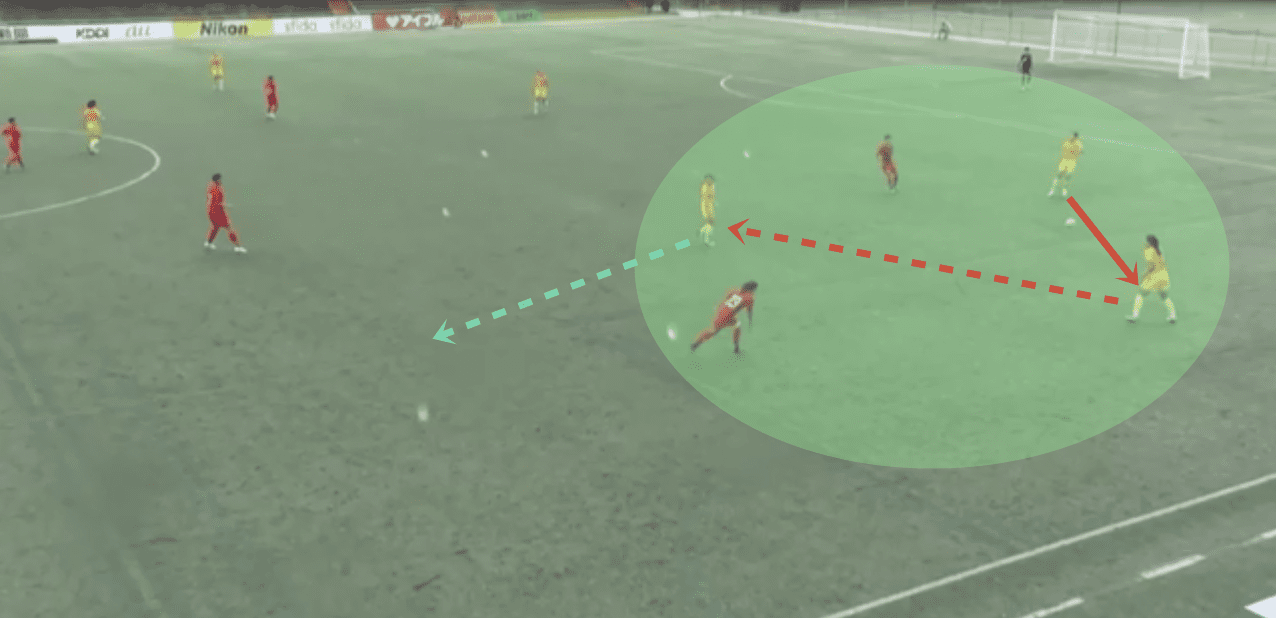
Here we see how the presence of regista helps China get past the two-man forward press as only one pass from one of the defenders can get past two forwards. In addition, the regista can also run in space and link with the fullback and the winger.
However, sometimes, the opposing team lends more players to the pressing than expected. In these scenarios, when there are upwards of two opposition players pressing, the Roses like to drop both of their midfielders. This makes a midfield pivot which can be used to create numerical superiority between the half-way line and the defence.
In these types of scenario, the fullbacks will drop deep to support the build-up action. With both fullbacks deep, there are now six players in China’s own half. Not only does this create numerical superiority in favour of China but it also creates two triangles on the wings.
Each of the triangles consists of a centre-back, midfielder, and fullback. China can utilize these triangles to concentrate build-up on one side of the pitch. After a sufficient of opposition players are attracted, China can quickly switch to the free centreback or fullback on the other side of the pitch and start a counterattack.
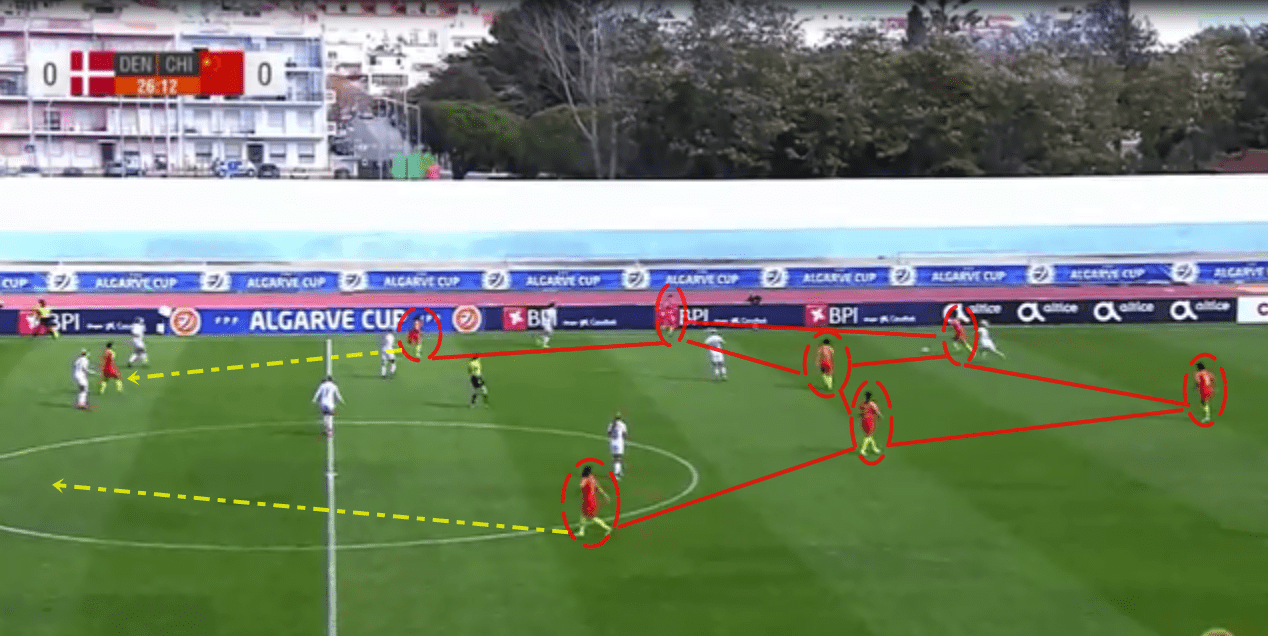
Here we can see the triangles on the right-hand side of the pitch. Additionally, notice how the midfield pivot can connect with the two wide wingers who can either go on dribbles and runs (shown in yellow) or pass to the striker (shown in yellow).
The triangles allow another opportunity to attack the opposition. The triad of players can keep passing between them which will allow them to get past opposition press on the wing. Simple actions such as a run-and-go and chipped balls can release fullbacks on the wing. From there the fullback and the winger can team up to directly attack the isolated opposition fullback or centreback.
China look towards wing combinations and their star player to hurt opponents
China’s attacking game plan, surprisingly, is very similar to that of Germany’s. China also like to predominantly utilise the wing play, although in a slightly different manner. While Germany are focused on direct linkup with the wingers and having various wing-play combinations, China tend to take some more time.
As such China are not looking for the winger or the fullback at every opportunity. Rather for China, it is a matter of working their way up the pitch and hitting the opposition hard. Sometimes this means that China will soak up pressure and will wait out for potential counterattacks.
This, however, does not mean that the Steel Roses lie dormant. They will actively pursue the ball and try to win the ball in very high areas. This is as, at any given moment, they will have two forwards right near the two centrebacks.
By winning the ball very high up the pitch, they can instantly start an attack by passing to one of the forwards. Since there is a 2v2 situation in the central corridor, the forwards can use quick interchange to attack the goal.
Moreover, China also know that to compensate such a vulnerable situation, the opposition will invariably utilise one of their fullbacks in attempts to create a 3v2 in the box. It is at that point where the wing play tactic of China comes to light as both of the wingers will start bombarding runs to the final third.
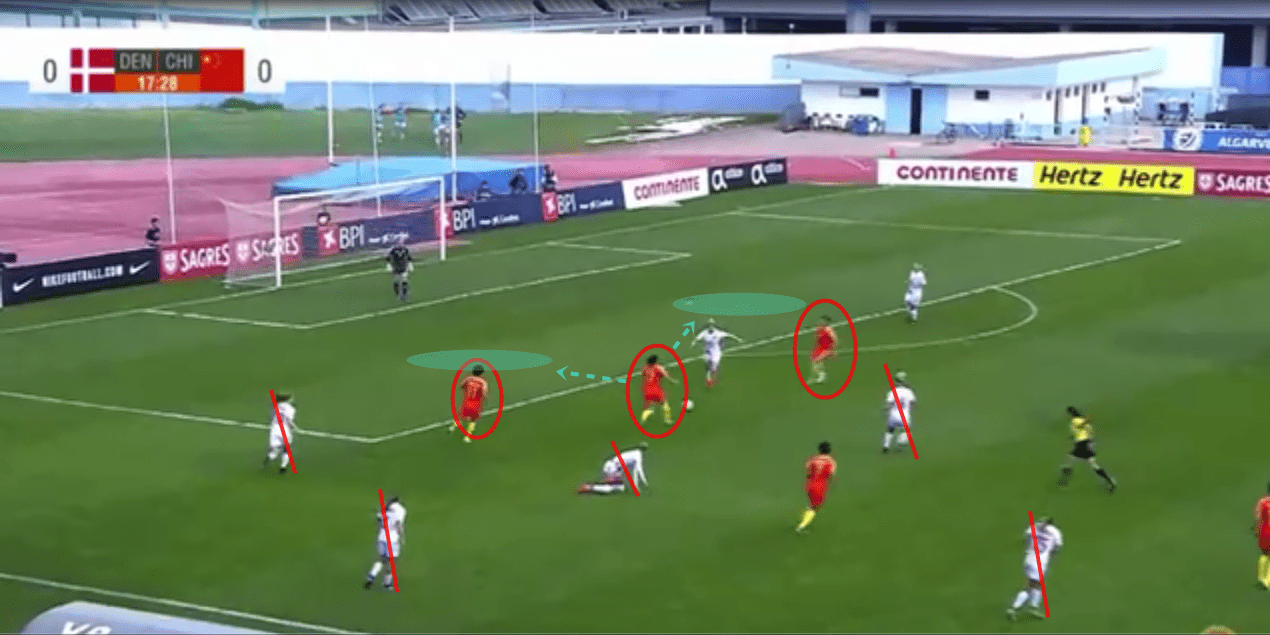
Here we see that through a high counter press, China glide past five players from the opposition. This leaves two defenders at the back. The three Chinese players create a 3v2 in where China can find dangerous spaces in front of the goal(shown in blue). The wingers can then work with the striker to create high-quality chances to score goals.
The forwards, especially the talented Wang Shuang, can hold up the ball and pass back to one of the midfielders who can play a through-ball to the winger making a diagonal run. From there, either one of the crosses or cutbacks to bring the strikers into the game.
While such counterattack is an ideal attacking game from China, they will use the movement from the two forwards to create space on the wingers. With a pocket of space on the wing flank, they will then use the interactions between their fullback and winger to get behind the opposition defence.
If all fails, China has, within them, their version of a Messi. Shuang, one of the forwards, can drop deep and take the ball in the middle of the pitch. Shuang is, with her short stature and amazing technical skills, and amazing dribbler and can easily glide past one or two opposition players.
Not only does she add the power for China to glide past defenders but she also a creative spark that they can be guilty of missing. Her imaginative passes include everything from chipped balls to no-look passes. Her mere presence should be enough for defences to be strict around her.
As such, Shuang can serve, through an indirect method, a catalyst for the attack. By attracting players, she can vacate spaces for her fellow teammates.
Conclusion
As we can see from the tactical preview, both teams will likely come out with guns flaring. The high octane style from each team suits their specific tactical actions and as such, it will be a great game. This game represents everything that the Women’s World Cup stands for: high-energy, courageous spirit, and a penchant for risks.
If you love tactical analysis, then you’ll love the digital magazines from totalfootballanalysis.com – a guaranteed 100+ pages of pure tactical analysis covering topics from the Premier League, Serie A, La Liga, Bundesliga and many, many more. Get your free copy of the FIFA Women’s World Cup 2019 Preview magazine right here and sign up for a ₤50 annual membership (12 monthly issues plus the annual review) right here

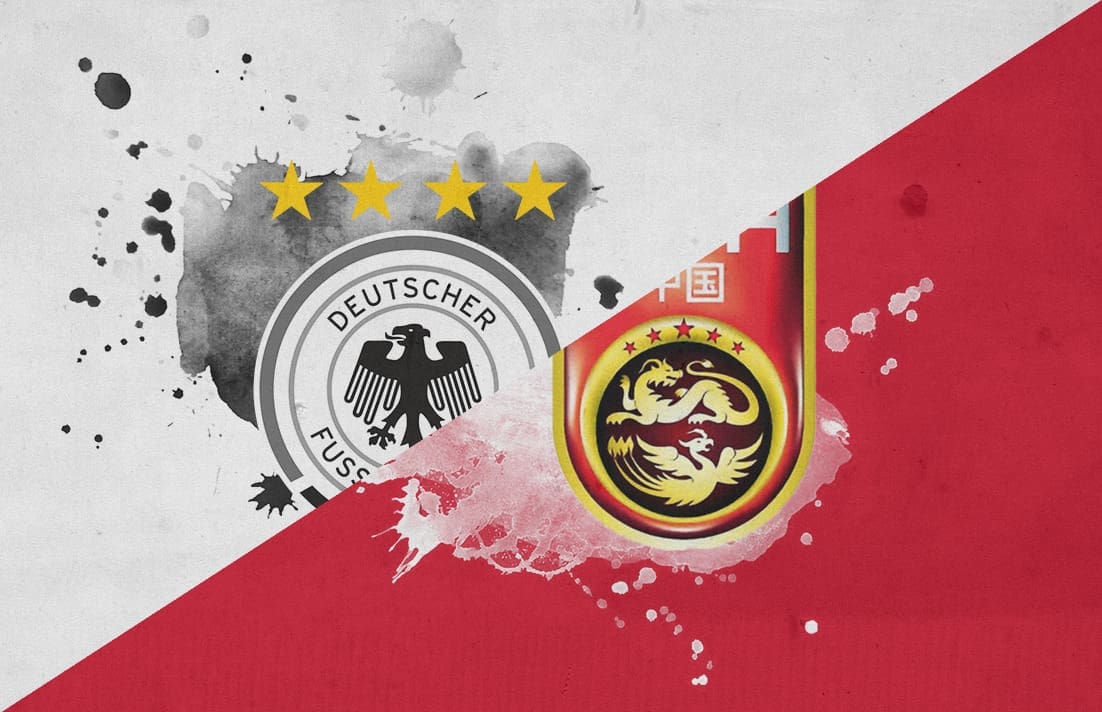



Comments